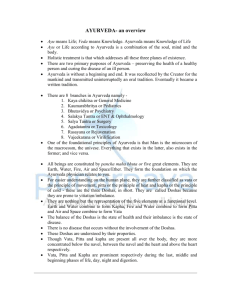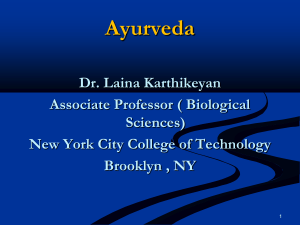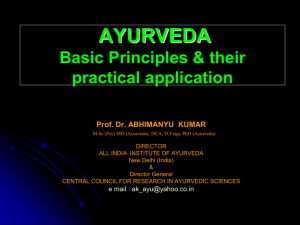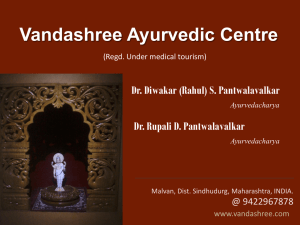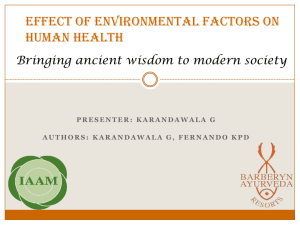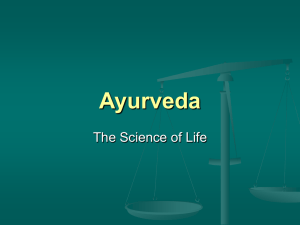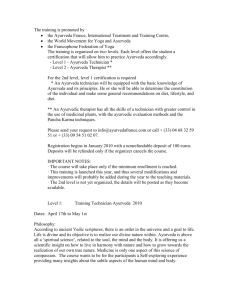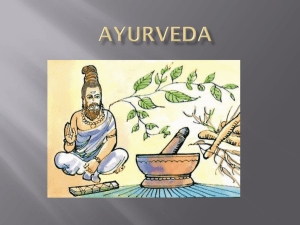Ayurveda - Carnoustie Resorts
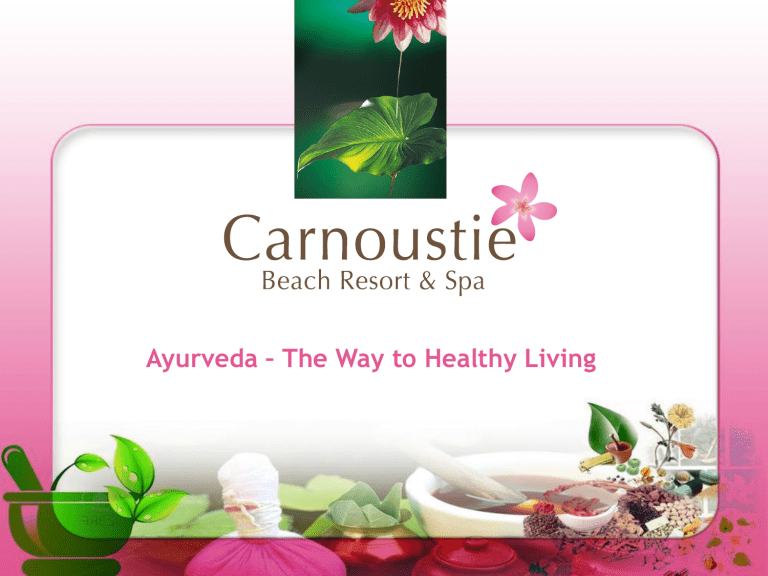
Ayurveda – The Way to Healthy Living
How can we uplift our Life by
Indian system of healing?
The Answer: through Ayurveda
What is Ayurveda?
(or Real meaning and aim of Ayurveda)
The term Ayurveda is taken from the Sanskrit words
ayus, meaning life or lifespan, and veda meaning
knowledge.
Just as everyone has a unique fingerprint, according to
Ayurvedic beliefs, each person has a distinct pattern of energy - a specific combination of physical, mental, and emotional characteristics
What is Ayurveda?
(or Real meaning and aim of Ayurveda)
AIM
The aim of this system is to prevent illness, heal the sick and preserve life. This can be summed up as follows:
• To protect health and prolong life ("Swasthyas swasthya rakshanam")
• To eliminate diseases and dysfunctions of the body
("Aturasya vikar prashamanamcha")
5 elements theory
(Body Constitution)
Ayurveda is based on the premise that the universe is made up of five elements: air,fire, water, earth and ether. These elements are represented in humans by three
"doshas", or energies:
1.
Vata:- pertains to air and ether elements
2.
Pitta :- pertains to fire elements
3.
Kapha:- pertains to water and earth elements.
5 elements theory
(Body Constitution)
When any of the doshas accumulate in the body beyond the desirable limit, the body loses its balance. Every individual have unique body constitution (Vata Pita Kapha) and each person is diagnosed as per his/her Body constitution
Definition of health according to Ayurveda
A healthy person, as defined in Sushrut
Samhita, one of the primary works on Ayurveda, is "he whose doshas are in balance, appetite is good, all tissues of the body and all natural urges are functioning properly, and whose mind, body and spirit are cheerful..."
3 root cause for manifestation of diseases
• Food – our eating habits
• Lifestyle – the way we live
• Time period ( according to age and period)
Food
8 Golden rules
Eight important rules are involved in the intake of a proper diet. These are called Asta Ahara Vidhi Visesayatana
1. Prakruti - (Constitution)
2. Karan -(Processing)
3. Samyog -(Combination)
4. Rashi -(Quantity)
5. Desha -(Place)
6. Kala-(Time)
7. Upayoga samstha -(intake of food)
8. Upayokta -(morality of individual who takes it)
Food
8 Golden rules
1. Prakruti -Nature of food articles.
Impact Of Food on body as per the constitution
Every individual have unique body constitution (Vata Pita Kapha)
Depending on our dosha, or constitutional type, some foods can be beneficial, and others should be avoided.
Food
8 Golden rules
Vata
Leads to : Anxiousness, Hyper activeness
Be cautious : Avoid following food
Big Beans, Big Pulses, Dry Food, Cauliflower, Taro
Do This
Take lukewarm fresh food with enough quantity of milk, butter.
Have more green vegetables, salads
Food
8 Golden rules
Pitta
Leads to : Anger
Be cautious : Avoid following food
Repeatedly hot, spicy, chilly food
Excess oily & alcohol, smoking
Do This
Have coconut water, lime juice or buttermilk often
Have sprouted food
Have Pineapple juice, butter, and grapes
Food
8 Golden rules
Kapha
Leads to : Laziness, Obesity
Be cautious : Avoid following food
Excess soft drinks, ice creams & milk
Chilled, sweet food
Do This
Have lukewarm water and limited food
Always have fresh hot food
Food
8 Golden rules
2. Karana - Method involved in the processing of the food articles.
Preparation is the process performed to modify the natural properties of substances. This modification is brought about by
• Dilution,
• Application of heat (vaporization, distillation and sublimation),
• Clarification,
• Emulsification,
• Storing,
• Maturing,
• Flavoring,
• Impregnation,
• Preservation.
Food
8 Golden rules
Recommendations
Pressure Cooker for Preparing food
Steamed food
Wash vegetables before slicing
Use Organic Food
Peel skin of vegetables and fruits if food is not organic
Condemnation
Microwave cooked food
Deep fried food
Stale food
Food
8 Golden rules
3. Samyoga -Combination of food articles
Combination is the combining together of two or more substances.
This chemical combination exhibits special properties which none of the substances ever possessed. The new property thus formed could be useful or in some cases harmful to the body .
Food
8 Golden rules
Examples of useful Combination
• Milk & Clarified Butter
• Milk & Turmeric
• Milk & Dry Ginger
• Milk & Honey
• Banana & Lukewarm Milk
Food
8 Golden rules
Examples of harmful Combination
• Milk & Eggs
• Milk & Meat products
• Milk & Salt
• Hot Drinks & Honey
• Wheat & Riceer
• Banana & Cold Milk
• Citrus & Milk Products
• Fruits & Meal (Gap of at least half hour is recommended)
• Combination Of Fruits
Food
8 Golden rules
4. Rasi - Quantum
The rasi (quantum) is the measure of the total mass of each constituent, which helps in determining the effects of the right and wrong doses of our diet. The measure of the entire meal as a whole is the total measurement of the diet. On the other hand measuring of each and every article of diet is called detailed measurement.
Similarly measuring the parts separately is also known as detailed measurement.
Example:- Never eat to a full stomach. Always leave the table with a feeling that you could eat more
Food
8 Golden rules
Rashi (Quantum) on different types of body constitution
Vata :-
Breakfast is highly recommended
Fluctuating
Pitta:-
Balance food throughout
Kapha:-
Light Breakfast
Spread meals
Food
8 Golden rules
5. Desa - Habitat/climate
Habitat is a geographic region. It indicates variations in equalities of substances due to difference in soil, use and climate
Examples:-
Recommended food for People living in Cold region
• Heavy food like meat etc.
• Heavy Milk products like Cheese , butter etc.
Recommended food for People living in Hot region
• Light Food
• Vegetables
• Milk
• Fruits
Food
8 Golden rules
6. Kala - Time
Time is used in two senses time in the general sense and time in the sense of a stage. Stage is used in relation to disease whereas time in the general sense is used in relation to seasonal wholesomeness.
Examples:-
Avoid curd at night.
Always have light Dinner
Food
8 Golden rules
7. Upayoga samstha - Rules governing the intake of food
There are certain dietetic rules, which need to be followed by one and all, and these are usually determined by the strength of digestion of a person. (On Doctor’s Prescription)
8. Upayoka - Wholesomeness of individual who takes it
The user is the one who makes use of food and habituation depends upon him. (On Doctor’s Prescription)
Lifestyle
Along with a balanced diet, incorporating other healthy habits into a daily routine can prevent disease at its very root. Ayurveda refers to daily healthy routine as
Dinacharya, which is the art of living in awareness with every activity of the day.
A lifestyle which incorporates regular eating and sleeping habits, as well as daily routine, will bring discipline and help maintain the harmony of the doshas, thus promoting overall good health.
Lifestyle
Examples Of Lifestyle leading to different doshas
Late night awake – Increases vata
Late Morning sleep – Increases Kapha
Untimely meals – Increases Pita
Examples of Lifestyle to be followed to control doshas
Wake up on time
Drink good amount of water
Exercise, yoga, Pranayam, Mudras ,Meditation
Diagnosis method
Pulse diagnosis (naadi parikshan)
General appearance of the patient and Examination of the constitution (Prakriti).
Therapies
• Panchakarma
If toxins in the body are abundant, then a cleansing process known as panchakarma is recommended to purge these unwanted toxins. This fivefold purification therapy is a classical form of treatment in ayurveda.
These specialized procedures consist of the following: a.
Therapeutic vomiting or emesis (Vaman) b.
Purgation (Virechan) c.
Enema (Basti) d.
Elimination of toxins through the nose (Nasya) e.
Bloodletting or detoxification of the blood (Rakta moksha)
Therapies
SPA a. Different types of massage according to your body elements b. Steam(By different types of herbs) c. Shirodhara (Oil being poured on head) d. Marma Therapy ( on vital points of body)
Different types of massages
1. Abhayanga
2. Pizichilli
3. Hot stone therapy
4. Uzhichil
5. Udvartna
CHERTHALA, DISTRICT-ALLAPUZA, KERALA, INDIA. Phone No.:+91-478-2865345
Website: www.carnoustieresorts.com
Corporate Office: A-150, SECTOR 43, NOIDA-201301, UP, India
Tele: +91-120-2570150 | Fax: +91-120-2577150
Mobile: +91-8826581582, +91-9910604383 | email: resorts@carnoustiegroup.com
Website: www.carnoustiegroup.com
